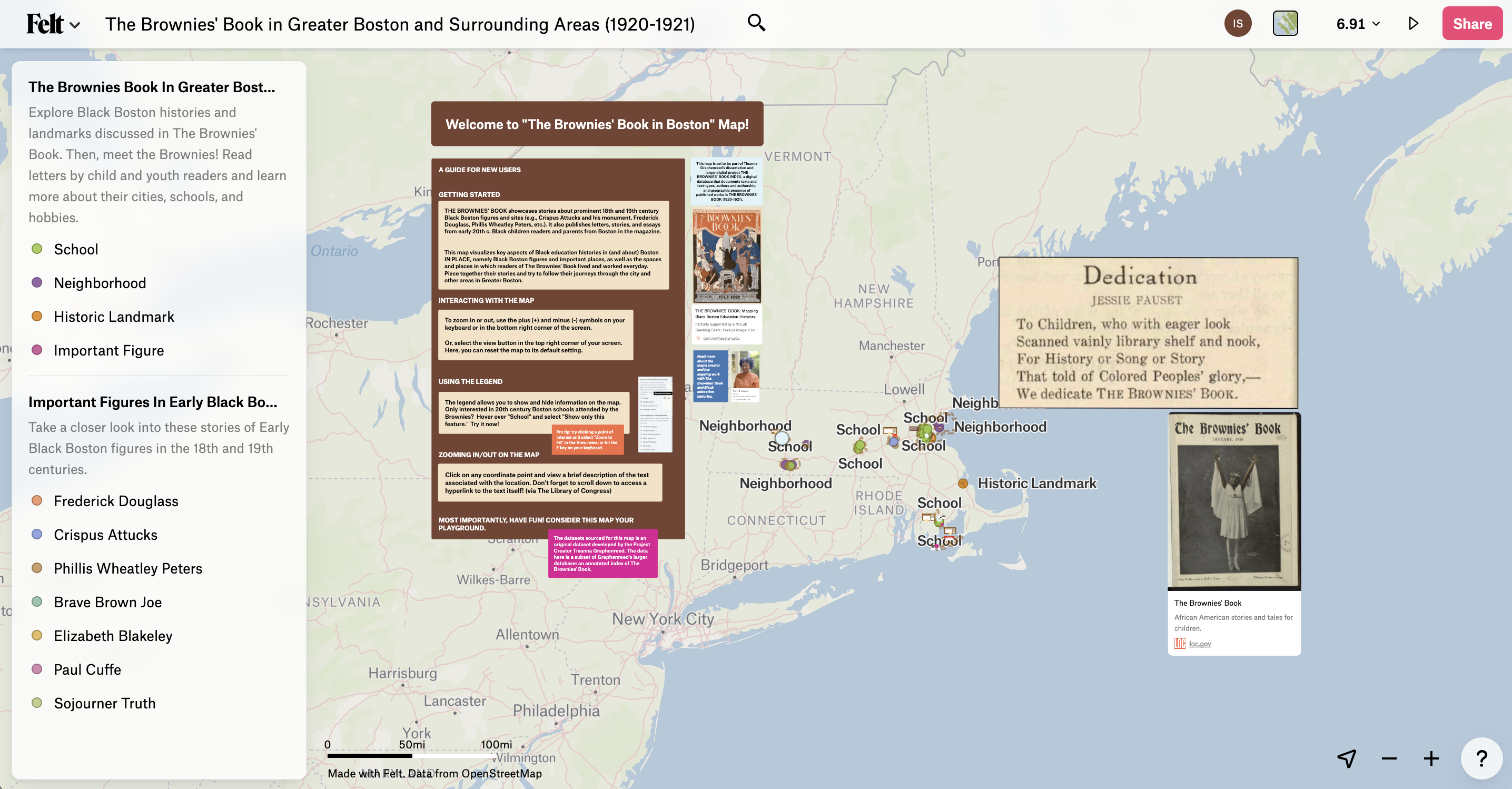This digital publication was supported by the Leventhal Map & Education Center’s Small Grants for Early Career Digital Publications program.
The Brownies' Book, published between January 1920 and December 1921, was an African American children’s periodical and one of the first print periodicals in the United States intended specifically for Black children writ large. It was developed by W.E.B. Du Bois, Jessie Redmon Fauset, and Augustus Granville Dill during the New Negro Renaissance (also known as the Harlem Renaissance).
My research involves constructing an annotated index of The Brownies' Book, and my dissertation focuses on mapping the circulation of The Brownies' Book within metropolitan Boston. In doing so, I found myself identifying rich geographies of learning in Black Boston’s education histories. "The Brownies' Book in Boston" interactive map takes a snapshot of the people, places, and events in Massachusetts, and especially the Greater Boston area, that were important for an emerging Black histories curriculum in post-WWI United States education. The map also illustrates children’s geographies alongside education geographies in greater Boston, by documenting the schools attended by readers of The Brownies' Book, their neighborhoods, and their places of work.
Reading as a spatial citizenship practice in Black children’s lives
In the early twentieth century, much like today, Black histories—in the U.S. and across the diaspora—were not often taught in the U.S. education system.1 The Brownies' Book directly intervened in the U.S. education curriculum by supplying knowledge about Black histories for use at school and at home. Prominent Black Boston figures appear often in the Book, setting the Greater Boston region apart from others in the U.S. Boston is of special interest perhaps because the city (and Massachusetts) went hand in hand with Northern liberation histories for Black people, and, beyond that, for the overall ideology of American freedom and patriotism: the Boston Massacre, the Shot Heard Round the World (Lexington & Concord), and the American Revolution.
In browsing the pages of The Brownies' Book, readers should take note that Brownies' was used as a textbook (or “reader”) in schools; it was not just read at home or in other spaces of leisure or play. Its existence is predicated upon call and response, and as such it invents and assembles itself in every issue through dialogue primarily with its children readers—what they want to see and learn, discussing seriously how they are feeling, and answering questions they have about the world. Columns like “Little People of the Month” and “The Jury"2—as well as the stories, art, and poetry authored by children and youth themselves—help celebrate the accomplishments of young persons and serve as a forum to discuss the concerns, dreams, and ideas of child/youth subjects. In looking toward how children and youth write of themselves and their lived experiences in the early 20th century United States, we acknowledge child/youth agency. In doing so, we stand to expand discussions of children’s geographies, child/youth rights, and their practices of citizenship.
The Brownies' in Boston interactive map
The interactive map—built using the platform Felt—visually identifies geographies of learning and education in Black Boston, including readers' homes and neighborhoods, schools and workplaces, notable sites and historic landmarks, and important Black Boston figures throughout the 18th and 19th centuries.
The map is geared primarily toward teachers and K-12 students at Boston Public Schools. Although The Brownies' Book materials are curated to be accessible enough for all grade levels and ages, the map may be best suited for interactive use by students grades 4–6. Often this is when the general education curriculum begins to teach about people and subjects in eighteenth and nineteenth century American history and important events of this period, like Crispus Attucks and the Boston Massacre.
The legend of this map includes the aforementioned geographies of learning as data points. As users navigate the map, they have the opportunity to engage with a variety of annotations that share historical fun facts, increase geographic awareness (and knowledge of local histories), and that link to additional reading and learning material.
A helpful feature of this software is its capability to embed links and resources. So, I’ve been able to link and share actual texts from The Brownies' Book (as discussed in correlation with Important Figures and their home/work geographies in the greater Boston area). Users can even read selections from The Brownies' Book by following the hyperlinks in the annotations for each data point.
The annotations and data used for this map are sourced from my larger database, The Brownies' Book Annotated Index, scheduled to launch in 2024.
Tieanna Graphenreed is an English PhD student at Northeastern University studying rhetorics of Black citizenship and Black spatial politics. Tieanna’s research explores questions of rhetorical citizenship through lenses of writing studies and civic rhetorical education, critical geographies of race and space, and digital humanities. Her dissertation focuses on building a digital index and web-based learning resource focused on The Brownies’ Book and its import to U.S. Black education histories. In addition to serving as Managing Editor for* Reviews in Digital Humanities, Tieanna has worked on digital projects with the Early Caribbean Digital Archive, Early Black Boston Digital Almanac, and Mapping Black London. Tieanna’s most recent article in Composition Studies*, co-authored alongside Professor Mya Poe, engages writing assessment research to consider classroom ecologies and forward antiracist genres and antiracist assessment practices in the classroom.
-
Although speeches by Black political figures sometimes appeared for elocution exercises in evening and night schools, these were few and far between. ↩︎
-
Examples from the inaugural issue of The Brownies' Book, published in January 1920. [https://www.loc.gov/item/22001351/] ↩︎
Our articles are always free
You’ll never hit a paywall or be asked to subscribe to read our free articles. No matter who you are, our articles are free to read—in class, at home, on the train, or wherever you like. In fact, you can even reuse them under a Creative Commons CC BY-ND 2.0 license.
